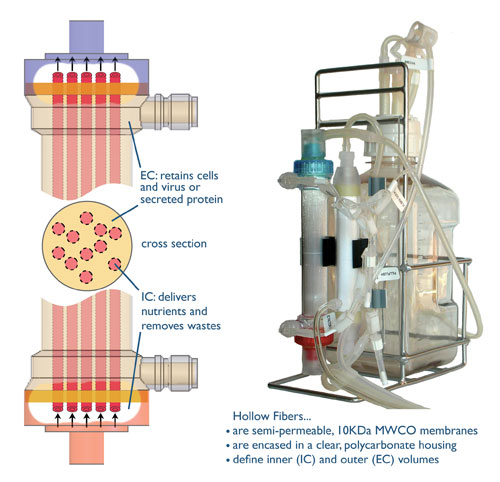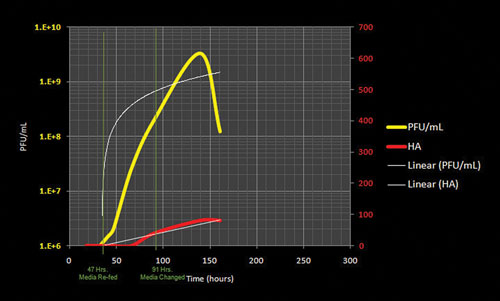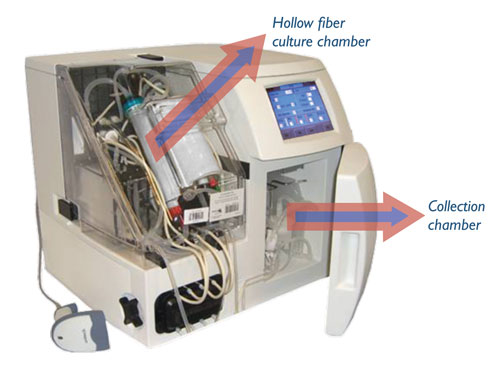June 15, 2011 (Vol. 31, No. 12)
Modular and Scalable Manufacturing Platform Has Application in Influenza Virus Production
The key benefit of hollow fiber bioreactor (HFBx) technology is the high cell density attained (>108 cells/mL) through the use of continuous media perfusion to feed cells and remove toxic wastes. These bioreactors consist of semi-permeable hollow fibers in parallel array housed within a polycarbonate shell (Figure 1).
There are two compartments within an HFBx: the intracapillary (IC) space within the hollow fibers and the extracapillary (EC) space surrounding the hollow fibers. The total volume within the polycarbonate shell that surrounds the fibers (EC space) depends on the size of the HFBx.
Typically, cells are seeded into the bioreactor EC space through a port on the top of the HFBx. Fresh medium is continually pumped through the lumen of the fibers. As the cell population expands, this medium feed rate is steadily increased to satisfy nutrient needs and prevent a buildup of metabolic waste. Depending on the average pore size of the semi-permeable hollow fiber membrane, larger MW components such as secreted protein (>10 KD) or viruses will be restricted from crossing into the IC space. Thus, concentrated product is typically harvested from the EC space at a steady rate for the duration of the culture.
Hollow fibers can be constructed from cellulosic, polysulfone, polypropylene, or polyethylene materials, thus allowing a choice depending on the characteristics needed for optimal protein or virus production. The vast majority of HFBx utilize cellulosic fibers for uniform cell expansion and production of mammalian cell-secreted products. Biovest International developed the first commercial-scale HFBx system in the mid 1980s, and ever since the most common application for this technology has been the large-scale production of monoclonal antibodies.
Hollow fiber bioreactors provide several fundamental advantages not found in other reactor systems currently used for virus production:
- growth of anchorage-dependent and independent cells at physiologic densities (>108 cells/mL) for extended periods of time (months),
- continual perfusion to promote normal cell function and 3-D interactions that cells normally experience in vivo, allowing for a more natural virus infection cycle,
- nutrient supply (sugars, amino acids, oxygen, etc.) at least as fast as cellular consumption requires, and removal of metabolic waste products (lactic acid, ammonia, etc.) at a rate that prevents toxic buildup,
- removal or dilution of harmful cytokines and virus-coded host shut-off proteins to avoid premature apoptosis,
- reduced labor requirements and user interactions, and
- virus containment in a small footprint for adaptation to BSL-2 and BSL-3 facilities.

Figure 1. Basic hollow fiber bioreactor design and the HF Primer™ small-scale bioreactor
Production of Influenza Virus
The threat of pandemic and avian influenza virus outbreaks and the need for vaccine preparedness to control these outbreaks has elevated interest in new production platforms that are less costly and cumbersome than current technologies. In this regard, embryonated hen’s-egg-based vaccines are now disappearing in favor of mammalian cell-based vaccines, which, while more convenient and reliable than egg-based vaccines, add another level of complexity to the manufacturing process.
Facing the probability of pandemic outbreaks and the worldwide costs tied to annual human influenza A epidemics, there is a need for new manufacturing technologies utilizing flexible and modular design systems that can improve vaccine-production capacity.
Along these lines, Biovest established a cooperative relationship with the Department of Respiratory Disease Research at the Naval Health Research Center to test the hypothesis that HFBx is an effective and relatively inexpensive production platform for rapid and cost-effective large-scale propagation of pandemic influenza virus isolates. The Biovest HF Primer™ was utilized for these studies. The Primer is a small HFBx designed specifically for R&D of processes that are directly scalable to the larger, more automated HFBx systems.
Methods
Bioreactor-adapted Madin-Darby Canine Kidney (MDCK) cells were grown in the presence or absence of fetal bovine serum in T-150 culture flasks and harvested at 80% confluency. 1×108 cells were added to a Biovest HF Primer unit through the EC portal and allowed to attach to the hollow-fiber membrane. Medium was continuously circulated through the bioreactor for 14 days until the total cell number reached approximately 1×109 cells.
On day 13, a separate flask of MDCK cells was infected with Influenza A/Mexico/4108/2009 H1N1. The following day the influenza virus-infected cells were collected, permeabilized, treated with a fluorochrome-labeled monoclonal antibody against influenza A virus nucleocapsid antigen, and the number of antigen-positive cells was counted using a fluorescent microscope.
Subsequently, 100 virus-infected cells in a 5 mL volume were introduced into the EC space of the bioreactor containing 109 uninfected MDCK cells. For the duration of this study, the bioreactor was maintained with continual medium perfusion in an incubator at 37°C with 5% CO2 atmosphere. To determine the rate of virus growth, samples (0.5 mL) were collected from the ECS at 24-hour intervals post infection (PI) and assayed for infectious virus.
Results
Figure 2 illustrates the amount of infectious (plaque-forming) virus observed at each time point PI. Note that at 140 hours post infection, virus titers reached 3 x 109 infectious units as determined by a plaque assay. Likewise, genomic equivalents (PCR) increased over a similar course and no detectable genetic mutation in HA was observed during the entire incubation period (data not shown). As with most influenza isolates, there are approximately 10–100 non-infectious particles for every infectious unit; thus, we believe that the total particle count was approximately 3 x 1010–3 x 1011.

Figure 2. Infectious virus (plaque-forming units). No genetic mutation in HA was observed at any point post infection (data not shown).
Discussion
While the Biovest HF Primer is useful for experimental needs, more sophisticated, automated, and higher production capacity units such as the AutovaxID (Figure 3) are needed for large-scale virus production. Since this system is functionally closed, yet automates mammalian cell processes, it is ideal for the production of viruses or cell-secreted proteins. A combination of pore-size selection and control of the fluid dynamics within the bioreactor encourages removal of harmful cytokines and virus-induced host shutoff proteins while maintaining virus stability.
Most importantly, the two-component design of the AutovaxID provides containment that minimizes the need for traditional cleanrooms, greatly reduces the risk of process contamination, and provides a small footprint that facilitates adaptation to existing BSL-2 or BLS-3 facilities.
AutovaxID is an example of how advanced hollow fiber technology can play an integral role in the manufacture of vaccines. In comparison to error-prone manual techniques or minimally customizable large-tank systems, the AutovaxID is:
- cGMP compliant and compact to minimize size requirements for manufacturing facilities,
- composed of disposable elements for all product contact components to maximize speed and manufacturing flexibility,
- self-contained, or functionally closed for avoidance of contamination and containment of infectious agents,
- automated to reduce operator intervention and expertise/skill levels, and
- designed to regulate perfusion rates for control of culture environments to enhance virus replication and stability.

Figure 3. AutovaxID™ with temperature-controlled incubation and collection chambers
Conclusions
Hollow-fiber bioreactors offer a compact, highly efficient, scalable, and economical method for virus production. The combination of an unlimited nutrient supply and the ability to de-bulk the culture through the cartridge ports allows the system to be maintained at relative equilibrium for extended periods.
This continuous production over long periods of time, rather than the batch-style approach of other systems, provides several benefits including consistency in culture conditions, dramatically increased production per unit footprint and culture volume, continuous or daily product harvest allowing timely and convenient stabilizing treatment for collection and storage, and selective dilution or removal of products from the culture that might be toxic or inhibitory to cells.
Mark Hirschel, Ph.D. ([email protected]), is CSO, and J. David Gangemi, Ph.D., is senior bomedical consultant at Biovest International. James McSharry, Ph.D., is senior scientist at Ordway Research Institute, and Chris Myers, Ph.D., is laboratory director, department of respiratory disease research, Naval Health Research Center.


